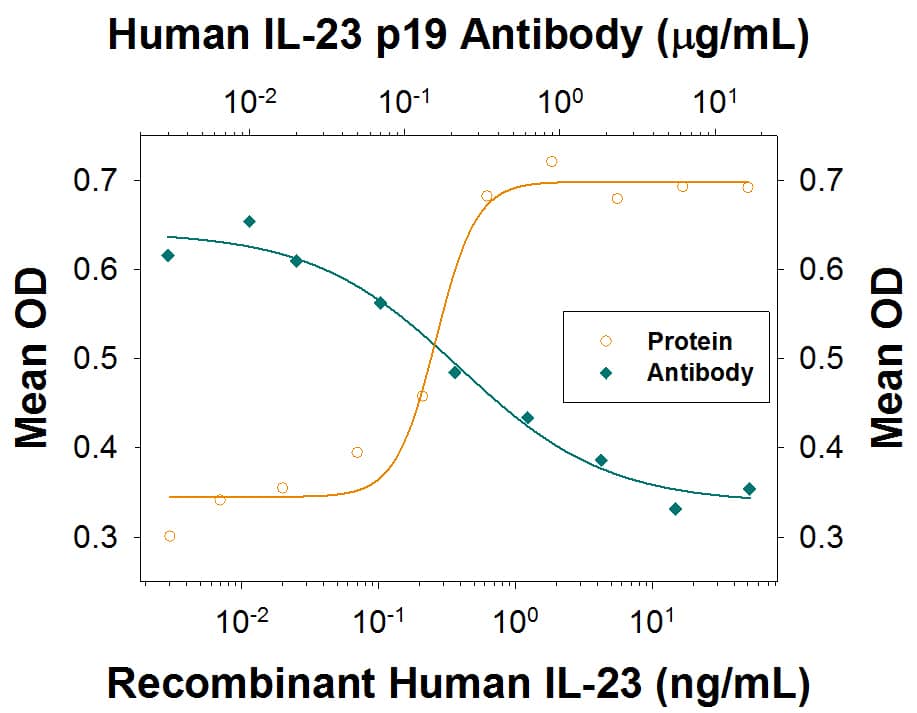Human IL-23 p19 Antibody
R&D Systems, part of Bio-Techne | Catalog # MAB12901

Key Product Details
Species Reactivity
Applications
Label
Antibody Source
Product Specifications
Immunogen
Arg20-Pro189
Accession # Q9NPF7
Specificity
Clonality
Host
Isotype
Scientific Data Images for Human IL-23 p19 Antibody
Detection of Human IL‑23 p19 by Western Blot.
Western blot shows lysates of CHO Chinese hamster ovary cell line either mock transfected or transfected with human IL-23 p19. PVDF membrane was probed with 1 µg/mL of Rabbit Anti-Human IL-23 p19 Monoclonal Antibody (Catalog # MAB12901) followed by HRP-conjugated Anti-Rabbit IgG Secondary Antibody (Catalog # HAF008). A specific band was detected for IL-23 p19 at approximately 19 kDa (as indicated). This experiment was conducted under reducing conditions and using Immunoblot Buffer Group 1.IL‑17 Secretion Induced by IL‑23 and Neutralization by Human IL‑23 Antibody.
Recombinant Human IL-23 (Catalog # 1290-IL) stimulates IL-17 secretion in mouse splenocytes in a dose-dependent manner (orange line), as measured by the Mouse IL-17 Quantikine ELISA Kit (Catalog # M1700). Under these conditions, IL-17 secretion elicited by Recombinant Human IL-23 (0.3 ng/mL) is neutralized (green line) by increasing concentrations of Rabbit Anti-Human IL-23 p19 Monoclonal Antibody (Catalog # MAB1290). The ND50 is typically 0.15-0.9 µg/mL.Applications for Human IL-23 p19 Antibody
Western Blot
Sample: CHO Chinese hamster ovary cell line transfected with human IL-23 p19
Neutralization
Formulation, Preparation, and Storage
Purification
Reconstitution
Formulation
Shipping
Stability & Storage
- 12 months from date of receipt, -20 to -70 °C as supplied.
- 1 month, 2 to 8 °C under sterile conditions after reconstitution.
- 6 months, -20 to -70 °C under sterile conditions after reconstitution.
Background: IL-23
Interleukin 23 (IL-23) is a heterodimeric cytokine composed of two disulfide-linked subunits, a p19 subunit that is unique to IL-23, and a p40 subunit that is shared with IL-12 (1-5). The p19 subunit has homology to the p35 subunit of IL-12, as well as to other single chain cytokines such as IL-6 and IL-11. The p40 subunit is homologous to the extracellular domains of the hematopoietic cytokine receptors. Human p19 cDNA encodes a 189 amino acid residue (aa) precursor protein with a putative 19 aa signal peptide and 170 aa mature protein. Human and mouse p19 share 70% aa sequence identity. Although p19 is expressed by activated macrophages, dendritic cells, T cells, and endothelial cells, only activated macrophages and dendritic cells express p40 concurrently to produce IL-23. The functional IL-23 receptor complex consists of two receptor subunits, the IL-12 receptor beta 1 subunit (IL-12 R beta1) and the IL-23-specific receptor subunit (IL-23 R). IL-23 has biological activities that are similar to, but distinct from IL-12. Both IL-12 and IL-23 induce proliferation and IFN-gamma production by human T cells. While IL-12 acts on both naïve and memory human T cells, the effects of IL-23 is restricted to memory T cells. In mouse, IL-23 but not IL-12, has also been shown to induce memory T cells to secret IL-17, a potent proinflammatory cytokine. IL-12 and IL-23 can induce IL-12 production from mouse splenic DC of both the CD8- and CD8+ subtypes, however only IL-23 can act directly on CD8+ DC to mediate immunogenic presentation of poorly immunogenic tumor/self peptide.
References
- Oppmann, B. et al. (2000) Immunity 13:715.
- Lankford, C.S. and D.M. Frucht (2003) J. Leukoc. Biol. 73:49.
- Parham, C. et al. (2002) J. Immunol. 168:5699.
- Belladonna, M.L. et al. (2002) J. Immunol. 168:5448.
- Aggarwal, S. et al. (2003) J. Biol. Chem. 278:1910.
Long Name
Alternate Names
Gene Symbol
UniProt
Additional IL-23 Products
Product Documents for Human IL-23 p19 Antibody
Product Specific Notices for Human IL-23 p19 Antibody
For research use only

